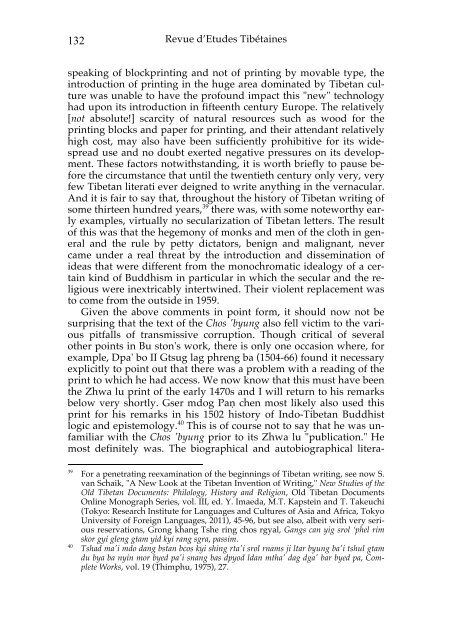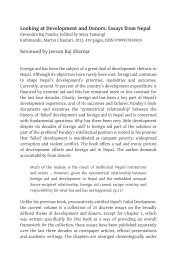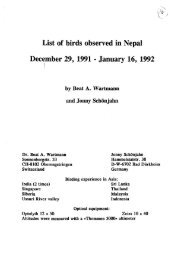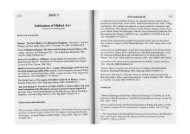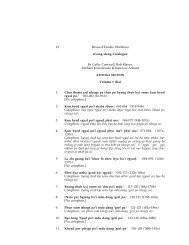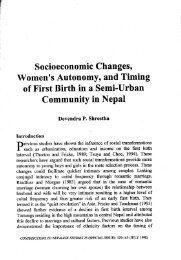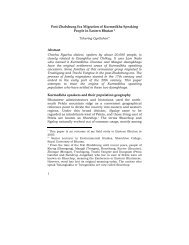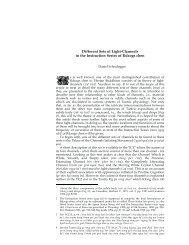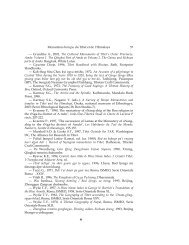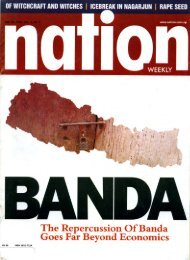Some Remarks on the Textual Transmission and Text of Bu ston
Some Remarks on the Textual Transmission and Text of Bu ston
Some Remarks on the Textual Transmission and Text of Bu ston
You also want an ePaper? Increase the reach of your titles
YUMPU automatically turns print PDFs into web optimized ePapers that Google loves.
132<br />
Revue d’Etudes Tibétaines<br />
speaking <strong>of</strong> blockprinting <strong>and</strong> not <strong>of</strong> printing by movable type, <strong>the</strong><br />
introducti<strong>on</strong> <strong>of</strong> printing in <strong>the</strong> huge area dominated by Tibetan culture<br />
was unable to have <strong>the</strong> pr<strong>of</strong>ound impact this "new" technology<br />
had up<strong>on</strong> its introducti<strong>on</strong> in fifteenth century Europe. The relatively<br />
[not absolute!] scarcity <strong>of</strong> natural resources such as wood for <strong>the</strong><br />
printing blocks <strong>and</strong> paper for printing, <strong>and</strong> <strong>the</strong>ir attendant relatively<br />
high cost, may also have been sufficiently prohibitive for its widespread<br />
use <strong>and</strong> no doubt exerted negative pressures <strong>on</strong> its development.<br />
These factors notwithst<strong>and</strong>ing, it is worth briefly to pause before<br />
<strong>the</strong> circumstance that until <strong>the</strong> twentieth century <strong>on</strong>ly very, very<br />
few Tibetan literati ever deigned to write anything in <strong>the</strong> vernacular.<br />
And it is fair to say that, throughout <strong>the</strong> history <strong>of</strong> Tibetan writing <strong>of</strong><br />
some thirteen hundred years, 39 <strong>the</strong>re was, with some noteworthy early<br />
examples, virtually no secularizati<strong>on</strong> <strong>of</strong> Tibetan letters. The result<br />
<strong>of</strong> this was that <strong>the</strong> hegem<strong>on</strong>y <strong>of</strong> m<strong>on</strong>ks <strong>and</strong> men <strong>of</strong> <strong>the</strong> cloth in general<br />
<strong>and</strong> <strong>the</strong> rule by petty dictators, benign <strong>and</strong> malignant, never<br />
came under a real threat by <strong>the</strong> introducti<strong>on</strong> <strong>and</strong> disseminati<strong>on</strong> <strong>of</strong><br />
ideas that were different from <strong>the</strong> m<strong>on</strong>ochromatic idealogy <strong>of</strong> a certain<br />
kind <strong>of</strong> <strong>Bu</strong>ddhism in particular in which <strong>the</strong> secular <strong>and</strong> <strong>the</strong> religious<br />
were inextricably intertwined. Their violent replacement was<br />
to come from <strong>the</strong> outside in 1959.<br />
Given <strong>the</strong> above comments in point form, it should now not be<br />
surprising that <strong>the</strong> text <strong>of</strong> <strong>the</strong> Chos 'byung also fell victim to <strong>the</strong> various<br />
pitfalls <strong>of</strong> transmissive corrupti<strong>on</strong>. Though critical <strong>of</strong> several<br />
o<strong>the</strong>r points in <strong>Bu</strong> st<strong>on</strong>'s work, <strong>the</strong>re is <strong>on</strong>ly <strong>on</strong>e occasi<strong>on</strong> where, for<br />
example, Dpa' bo II Gtsug lag phreng ba (1504-66) found it necessary<br />
explicitly to point out that <strong>the</strong>re was a problem with a reading <strong>of</strong> <strong>the</strong><br />
print to which he had access. We now know that this must have been<br />
<strong>the</strong> Zhwa lu print <strong>of</strong> <strong>the</strong> early 1470s <strong>and</strong> I will return to his remarks<br />
below very shortly. Gser mdog Paṇ chen most likely also used this<br />
print for his remarks in his 1502 history <strong>of</strong> Indo-Tibetan <strong>Bu</strong>ddhist<br />
logic <strong>and</strong> epistemology. 40 This is <strong>of</strong> course not to say that he was unfamiliar<br />
with <strong>the</strong> Chos 'byung prior to its Zhwa lu "publicati<strong>on</strong>." He<br />
most definitely was. The biographical <strong>and</strong> autobiographical litera-<br />
39<br />
40<br />
For a penetrating reexaminati<strong>on</strong> <strong>of</strong> <strong>the</strong> beginnings <strong>of</strong> Tibetan writing, see now S.<br />
van Schaik, "A New Look at <strong>the</strong> Tibetan Inventi<strong>on</strong> <strong>of</strong> Writing," New Studies <strong>of</strong> <strong>the</strong><br />
Old Tibetan Documents: Philology, History <strong>and</strong> Religi<strong>on</strong>, Old Tibetan Documents<br />
Online M<strong>on</strong>ograph Series, vol. III, ed. Y. Imaeda, M.T. Kapstein <strong>and</strong> T. Takeuchi<br />
(Tokyo: Research Institute for Languages <strong>and</strong> Cultures <strong>of</strong> Asia <strong>and</strong> Africa, Tokyo<br />
University <strong>of</strong> Foreign Languages, 2011), 45-96, but see also, albeit with very serious<br />
reservati<strong>on</strong>s, Gr<strong>on</strong>g khang Tshe ring chos rgyal, Gangs can yig srol ‘phel rim<br />
skor gyi gleng gtam yid kyi rang sgra, passim.<br />
Tshad ma'i mdo dang bstan bcos kyi shing rta'i srol rnams ji ltar byung ba'i tshul gtam<br />
du bya ba nyin mor byed pa'i snang bas dpyod ldan mtha' dag dga' bar byed pa, Complete<br />
Works, vol. 19 (Thimphu, 1975), 27.


